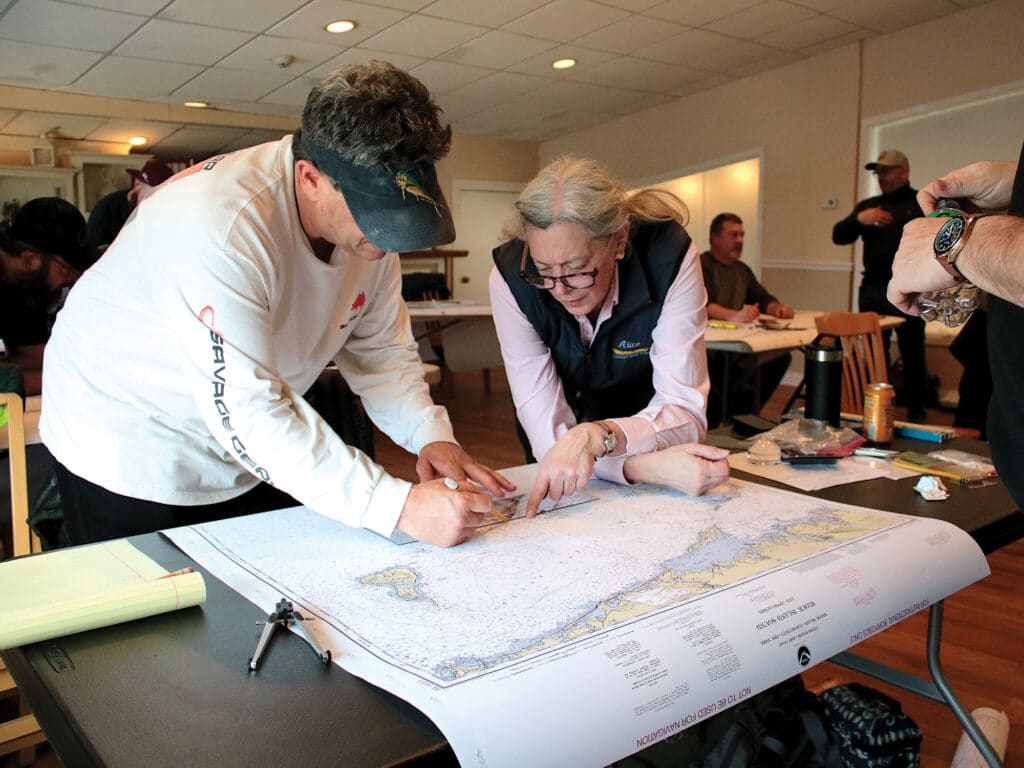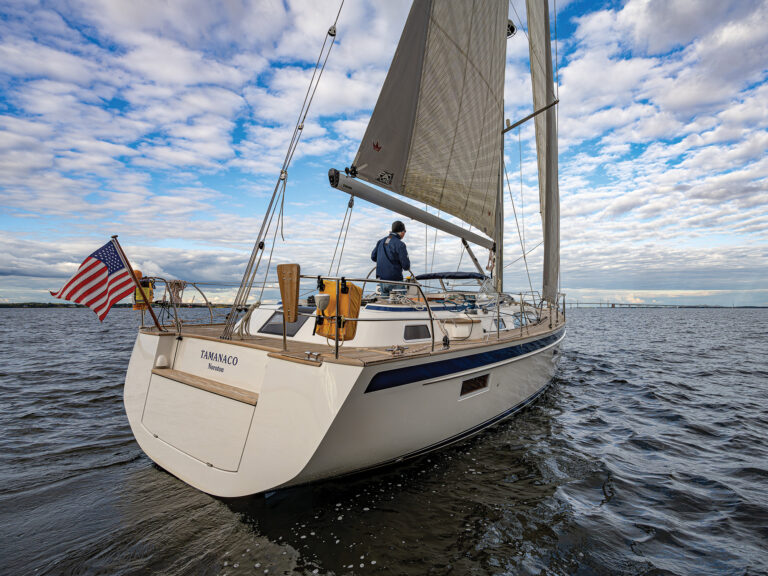
It was early afternoon on Day One of a weeklong course to prepare for the US Coast Guard’s captain’s exam, and besides my head feeling like a balloon about to pop, already several pages of my notebook were filled with hastily scribbled notes, including this gem: 1.169 x square root of light height = geographical range. Who knew I’d have to know that?
During the course of the morning, we’d slogged our way through license requirements, calculating days underway inshore and seaward of the boundary line that wraps like a string around the offshore points along America’s coasts. We’d touched on license endorsements, required publications when carrying passengers, and a list of additional things we’d need to procure before applying for any license. Things such as a Department of Transportation physical, CPR and first-aid cards, and a Transportation Worker Identification Credential.
We discussed in detail aids to navigation, buoy functions, beacons, light characteristics, Intracoastal Waterway navigation, light ranges, weather patterns and cloud identification.
And in between it all, Capt. Greg Metcalf, owner of the Atlantic Captain’s Academy, and instructor Capt. Chris Davis, an ex-Coastie-turned-towboat-skipper, spun entertaining sea tales and bantered back and forth with the 12 students—nine would-be tuna charter captains, a mate with a family tour boat that runs on the New Jersey coast, and a couple of sailors—who had committed to this immersive experience, held in a hotel conference room on the banks of the Annisquam River in Gloucester, Massachusetts.
That first day, a Sunday, as Metcalf outlined what we’d cover before taking four individual exams the following Sunday, he assured us of one thing: We’d make it through. ”Anyone know a charter captain?” he quipped. “Do they seem like rocket scientists?”
And then there were Davis’ two fundamental rules of navigation that we’d be reminded of again and again: “No. 1: Never hit bottom. No. 2: Never hit anyone else.”
Different Routes, Same Waypoint
There are all sorts of good reasons for mariners to consider becoming licensed captains. In the class that I took, several of the students were fishermen who had spent years on boats of all sizes, either chasing sport fish or fishing commercially. A license would allow them to take paying passengers out on charters, or it would let them command boats on which they’d been deckhands. A Maine lobsterman wanted to take tourists out on Sundays and charge them to haul traps on days when commercial lobstering isn’t permitted in that state. One woman, a school nurse, had summer jobs lined up driving launches out to islands off the Merrimac River.
Me? I do some teaching at a sailing center in Boston, and a ticket would let me spend more time on the bigger boats and run an occasional charter.
The basic license, Operator of Uninspected Passenger Vessels, is where it all starts. Sometimes called a “six-pack license,” it allows a holder to carry up to six passengers for hire in coastal waters. To qualify, besides passing the US Coast Guard exams, you need 360 documented days underway, 90 of which must have been in the past three years. The next step is to pursue Master credentials. At the Atlantic Captain’s Academy, this involves a two-day course on top of the OUPV curriculum. A Master allows you to captain a Coast Guard-inspected vessel with more than six passengers. The size of the boat and where it can be operated depends on your prior experience.
With various study options from which to choose, an eight-day in-classroom course worked the best for me. Setting aside a single solid chunk of time was easier to plan for than committing to a longer time frame, and the course in Gloucester was relatively close to where I live. Metcalf offers courses in several other New England locations, as well as online instruction.
Alternatively, Steve Wilson, the lead instructor at the Boston Sailing Center, who along with a friend had plans to be in Florida for the winter, opted to take one of Metcalf’s online programs that met in a Zoom classroom for three hours every Monday and Wednesday night for nine weeks, starting in January. When they returned to the Boston area in late spring, they and most of their Zoom-mates met in Maine for a day to take the proctored exams for OUPV credentials.
“Anyone who embraces Zoom technology and can learn that way, it’s awesome,” Wilson says. Before each class, he spent time becoming familiar with the material in Metcalf’s textbook, and after each class, he and his partner spent additional hours studying, working through exercises, and taking practice tests. He estimates that involved another 12 or so hours a week, sometimes a bit more. Near the end of the course, Metcalf held two optional weekend study days, and he was available throughout to answer questions over the phone or by email, Wilson says.
During the online course, students had ample time to get to know one another, Wilson says, and his classmates came from a variety of backgrounds, as was the case with my class. A few of the students in his class were auditing the course with no intention of taking the exam at the end. They just wanted to learn the material to become better boat operators.
Cruising Solo
While the Atlantic Captain’s Academy and many other schools across the country offer a variety of schedules that employ Coast Guard-approved curricula to help mariners earn their credentials, they aren’t required.
Tim Murphy, a CW editor-at-large and a New England-based marine journalist, first earned his OUPV credential when he was 18 and living in New Orleans. In high school, he’d signed up as a trainee on the brigantine Young America and was invited back as a volunteer. That, in turn, led to a six-month job crewing, so he was at sea every day and able to rack up 180 days of sea time. Meanwhile, his family was living aboard, and with them, he sailed all throughout the Bahamas, so in a period of three years, he had all the sea days needed.

Murphy says that a car accident during the summer after his senior year left him idle for a few months, so he spent the time studying and memorizing Chapman Piloting & Seamanship. He also used flash cards his father had employed while earning his own license to memorize all the mnemonics sailors rely on to remember navigation rules. Then he walked into Coast Guard headquarters and passed the tests. A year later, when he turned 19, the minimum age for Master credentials, he qualified for a license allowing him to captain vessels up to 100 tons, 200 miles offshore.
Murphy let his ticket expire in the 1990s, but in 2018, after buying hisPassport 40, Billy Pilgrim, with the intention of going off cruising with his partner, he decided to renew his credentials and used a few texts the boat’s previous owner had left to prepare on his own again.
“It was so hard,” he says with a laugh. “It was really hard.” But ultimately successful. Murphy again now holds those same Master’s credentials and will be able to use them if the opportunity arises in his travels.
By the Book
Back in the hotel in Gloucester for Day Two, we spent more time going over currents and tides, and then many hours poring over navigation rules. That night, we went home to review navigation general material—buoys, lights, weather—and took a practice test that we corrected in class the next day.
Day Three was all about mnemonics. “Red over red, captain is dead,” meaning the lights displayed on a vessel not under command. “Red over white, a fishing boat at night,” meaning a commercial fishing boat not trawling. “Red over green, sailing machine,” meaning a sailboat displaying its masthead tricolor. They were endless. “Turn to port, go to court,” meaning what action to take as a give-way power vessel in a crossing situation.
There were horn signals to memorize, whistles, gongs and bells. All followed by practice quizzes and more practice quizzes. Ditto on Day Four.
On Thursday, Capt. Davis had us roll out the paper charts and grab our Weems & Plath plotting tools and dividers for a three-day deep dive into current set and drift, plotting, dead reckoning, speed, fuel—you name it. I’m not sure I’d ever used up an entire eraser before.
Then finally, on Sunday, it was the day of reckoning, with exams in Navigation General, Chart Plotting, Rules of the Road, and Deck General. Navigation and Deck required minimum scores of 70 percent. The other two, 90 percent.
It was intense. It was challenging. But in the end, Metcalf was right: It was doable.
That afternoon, a few of us stuck around to study and take an add-on exam for a towing endorsement. And a couple of weeks later, most of us turned up for the two-day Master’s course. Two of us also opted for sailing endorsements.
So what’s the plan? Well, that’s still in the works. But already my Inland Waters Master credentials have earned me a few bucks and provided some new opportunities. And one thing I know for certain after a full summer on the water is that I’m definitely a better and more knowledgeable sailor. For that alone, it was well worth the effort.
Mark Pillsbury is a CW editor-at-large.








